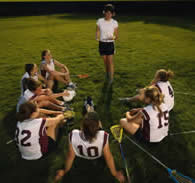Compiled by Kristen Cole Dec. 11, 2008
 Q & A with Professor and Author James Johnson Q & A with Professor and Author James Johnson
Professors James H. Johnson and Barbara A. Brehm, both of the Exercise and Sport Studies Department, recently collaborated with a faculty member at The Sage Colleges, Esther M. Haskvitz, to write “Applied Sports Medicine for Coaches.” In an interview with the News Office, Johnson talked about the new book, published by Lippincott Williams & Wilkins.
How common are sport injuries?
Johnson: About 3.5 million sport injuries are reported each year. Many more are unreported. These injuries cost billions of dollars and can have lifelong negative effects, including the cessation of activity. For example, the incidence of osteoarthritis rises significantly for those who suffer various sport injuries. As the increase in lifelong sport participation increases, so do sport injuries. Baby Boomers are beginning to suffer many more injuries than ever. At the other end of the age spectrum, about 50 percent of injuries to children are now classified as overuse injuries. This was mostly unheard of until children started to specialize – that is, play one sport all year.
What is the audience for this book?
Johnson: High school and college coaches of men and women are our primary audience. Our publisher is primarily a textbook publisher. However, individuals who train children should read this text. Children, especially, are specializing in sport and are quite vulnerable to injury. Unfortunately, many coaches in children's leagues have little formal training.
Is sports medicine too big of a role to ask coaches to take on?
Johnson: First, sports medicine is a very broad area. It includes exercise physiology, applied anatomy, biomechanics as well as areas traditionally thought of as medicine. Whether coaches wish to take on the role or not, one responsibility of the coach is not to harm their athletes. There are very specific practices a coach can utilize that train athletes while preventing injury. Sport injuries are the bane of athletics. If coaches can train their athletes for competition while also preventing injury, they have done their job.
None of the authors are doctors. Was it difficult to translate medical jargon into layman's terms?
Johnson: Most of the research on injury prevention is not conducted by physicians but exercise scientists. And this is our strength – the result of many years of applying information.
There are loads of books about sports medicine. Why did you write this one?
Johnson: For more than 20 years we have focused our graduate program on the practice of coaching women’s teams. With such a small department, we believed it was best to just do one thing and do it well. We now have the highest-ranking coaching education program in the country. My focus has been on how to apply exercise science knowledge to coaching. As a result of our experience, we became aware that sports medicine courses are not written for coaches but for medical personnel. Coaches are normally required to take a course on the care and prevention of injury but the texts are not written for the coaches. Texts are loaded with information on diagnosis and treatment, for example, areas that are not the responsibility of the coach but the athletic trainer and physician. Coaches must know how to prevent injury, to understand how injuries occur and how to keep athletes healthy. That is the content of our book.
-30-
|























